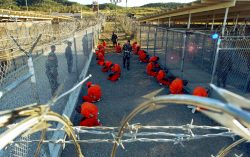 The Stanford experiment in 1971 is one of the most famous experiments in social psychology: its dramatic results lead to the need of forcing its interruption after only six days. Some boys, without a past of deviance, were divided into two groups to simulate a prison activity; in no time the guards became sadistic and abusive and the prisoners showed obvious signs of stress and depression. The experiment took place in a prison set up for the occasion in the university underground and was characterized by the high level of brutality and depersonalization tacitly accepted by the supervisors.
The Stanford experiment in 1971 is one of the most famous experiments in social psychology: its dramatic results lead to the need of forcing its interruption after only six days. Some boys, without a past of deviance, were divided into two groups to simulate a prison activity; in no time the guards became sadistic and abusive and the prisoners showed obvious signs of stress and depression. The experiment took place in a prison set up for the occasion in the university underground and was characterized by the high level of brutality and depersonalization tacitly accepted by the supervisors.
In 2003 the Stanford experiment became topical when it became known to the world that numerous sadistic and criminal abuses were inflicted by the US military on several detainees at the Abu Ghraib prison in Baghdad. The violence and the systematic torture of detainees were perpetrated by several members of the military police force (372 Military Police Company, 320 Battalion, 800 Brigade) in Section 1-A of the Abu Ghraib prison. The jail in Iraq, run at the time by the US Army, became notorious around the world for its pictures of an American soldier carrying a naked detainee on a leash, of naked detainees stacked on one another, of a hooded prisoner with electrical wires on his hands.
These photos of naked men, sometimes forced in humiliating and sexually explicit poses, were extremely similar to those made at the Stanford University in 1971.
It is therefore reasonable to think that in Iraq, as it did happen in Stanford, there was a tacit authorization by the military higher ranks and that, most importantly, the consequences on the detainees may have been the same: the appearance of forms of psychosis and depression or overt psychiatric pathology.
Richard Clarke explained, in his book “Against All Enemies”, the actions of the United States in the Persian Gulf made al-Qaeda. But during the presidential terms of George W. Bush (January 20, 2001 – January 20, 2009) there were thus created the basis for the development of the current international Islamic terrorism. In 2002, Bush opened the the Guantanamo Bay detention camp in Cuba but also other United States military prison in Iraq. It has long been known that Al Baghdadi, the Iraqi terrorist and Caliph of the self-proclaimed Islamic State, had been jailed by the Americans during the occupation of Iraq, but until now it was believed that he had been imprisoned at Camp Bucca, in the south of the country.
According to certain US military sources, this information is not accurate or it was spread with the specific intention to cover the facts. “The Intercept”, the online site managed by Glenn Greenwald (the journalist who published the revelations of Snowden), reports that the ISIS ‘Caliph’, Abu Bakr al-Baghdadi was detained with the registration number US9IZ-157911C by the US forces in the notorious Iraqi prison Abu Ghraib, where some of the most severe torture and worst human rights violations occurred.
Abu Bakr al-Baghdadi, leader of the Islamic State group controlling the east of Syria and the western Iraq, began his “career” in the Iraqi resistance in 2003 after being tortured by US administration. In 2006 he joined the group then called Al Qaeda in Iraq, composed of jihadis from various Sunni Arab countries that had entered into Iraq to fight the invading infidels to the then leader Abu Musab al Zarqaw. On the death of Zarqaw in 2006, Baghdadi, already at the top of the jihadi organization, had then free-way to self-proclaim himself as “Sheikh” of what we now know as ISIS, Is, DAESH or Islamic state.
In early 2003, the White House staff could not be unaware that the information of the “intelligence” used to justify the invasion of Iraq was false, because they were themselves to produce the “evidence”. We owe a lot, therefore, to the “neo-conservatives” of the George Bush administration who insisted on invading Iraq: Dick Cheney (vice president), Donald Rumsfeld (defense secretary) and Paul Wolfowitz (under-secretary of defense) who used the September 11 attacks as a means to their pre-existing plans of invading Iraq from where then terrorism originated as we know it now.
The errors and the poorly sighted visions of the United States in the context of the Gulf wars and Afghanistan, as well as the Middle Eastern dubious allies, have had a significant weight on the escalation of terrorism and war in the Mediterranean basin and Europe. But there is also the question on whether or how much the delusional program of al Baghdadi could be the result of a psychiatric deviance as a consequence of the tortures in the Iraqi prison during the American management.






